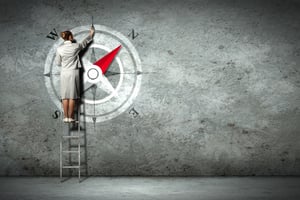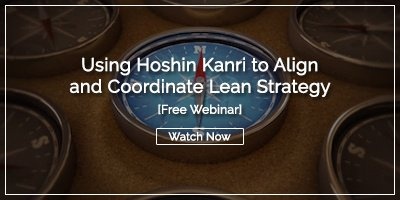 Also known as “strategy deployment,” Hoshin Kanri aligns an organization’s functions and activities within its strategic objectives. The collaborative learning method and resource development system allows organizations to leverage their scarce resources.
Also known as “strategy deployment,” Hoshin Kanri aligns an organization’s functions and activities within its strategic objectives. The collaborative learning method and resource development system allows organizations to leverage their scarce resources.
KaiNexus sat down with Craig Vercruysse and Joanna Omi—Partner and Consulting Director, respectively, at Moss Adams—to discuss how they’ve used Hoshin to get their clients aligned and help fuel their performance. You can view the full webinar here.
Using Hoshin Kanri to Align and Coordinate Your Lean Strategy
In this webinar you will learn:
- How the Hoshin practice evolves over time
- When to use an X-Matrix vs. an A3
- The relationship between visual management and Hoshin Kanri
- The relationship between developing people and the must-do, can’t fail few Hoshins
Hoshin Kanri as an (S)PDCA
You’re likely familiar with the PDCA (Plan-Do-Check-Act) strategy. Hoshin, however, takes PDCA a step further in that before organizations start planning, they must scan their environment. This helps to ensure all stakeholders understand the need for continuous improvement.
Think of it as an (S)PDCA:
- Scan to fertilize the ground—that is, to encourage team members to provide constructive feedback. Scanning is closely linked to nemawashi, or “pre-discussion,” which lays the foundation for change.
- Plan with the organization’s mission, vision, and values in mind. Identify the True North dimensions and targets, relevant themes, one-year goals, and responsible managers and sub-teams. While planning, don’t forget to play catchball, which promotes alignment by having one person articulate their ideas before “throwing” them to others for feedback.
- Do implement the Hoshin plan on behalf of the organization.
- Check to ensure success by testing the strategic outcomes and holding monthly management meetings.
- Act if and when fall-off occurs. Develop countermeasures if needed.
The environmental scan—which includes an A3i (the “i” stands for “intelligence report”—is a critical addition to the Hoshin process. It allows the organization to see where it is in relation to meeting a specific demand in the marketplace.
When Is an Organization Ready for Hoshin Kanri?
Hoshin represents an opportunity to develop people across all levels of the organization. The first step is exploration, with the aim of gaining a basic understanding of Lean tools and applications.
In simple terms, to understand Hoshin, the organization must be familiar with Lean strategy. The next step includes early attempts at deploying Hoshin. At this time, the process is not cascaded beyond leadership, and the organization might start testing tiered measurement and visibility walls.
In the third step, Hoshin is cascaded through several tiers of the organization. It is not fully integrated, but begins to be reflected in the daily management system.
Finally, in the fourth step, Hoshin is cascaded from the top throughout the organization. It rolls up from the Gemba in this way—for instance, think of the often-told story of a NASA janitor who proudly claimed, “I help put a man on the moon.”
Let’s go back to the word “tier” for a moment. It’s worth noting that Hoshin functions across four levels:
- Tactical (executive) – Providing a vision for the organization
- Operational (director) – Taking the organization’s vision and bringing it to a particular department
- Active (manager) – Focusing on a specific portion of a departmental problem
- PDCA (staff) – Continually testing alternatives to assess the problem
And testing is essential—Hoshin Kanri, after all, is a multi-year process that can evolve over time based on the direction the organization is taking.
That's all for now, for more information on this topic, check out the full webinar!



Add a Comment